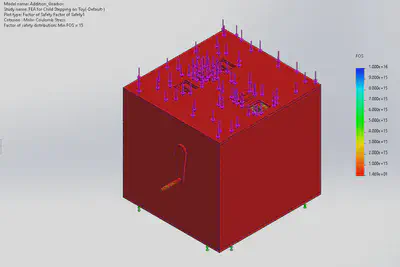Addition/Subtraction Toy
For this project, my teammate and I were tasked with designing a children’s toy to teach kids addition and subtraction. Both of us are members of Columbia Formula Racing, so we decided to base our idea around the concept of a differential gearbox. By running the differential in reverse, we were able to turn two inputs (the two numbers to be added or subtracted) into one output (the sum or difference of the two numbers).
Below is a video of the working design:
While the design originally started out simple, we continually added features to the toy as we designed it. For example, we added stops to the dials that prevent the input dials from rolling backwards from 0 to 9 and forwards from 9 to 0. We also added a second set of gears to the subtraction gearbox to prevent invalid equations and negative numbers. To go above and beyond, we also ran a quick FEA to test if our design would withstand a small child standing on it. While we did not redesign the toy to account for stress concentrations that would influence the results of the FEA or run a mesh convergence test, the analysis yielded a factor of safety of 1.47. Given the loading conditions, this was determined to be more than reasonable. If we were to continue the project, I would have redesigned the toy to minimize the stress concentrations at the sharp edges and done a mesh convergence test to ensure the validity of our results.


To provide a 3D view of the toys we designed, below are embeds of the SOLIDWORKS assemblies. If you would like to see the original project files with working mates, please send me an email!